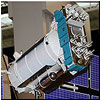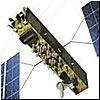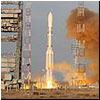|
GLONASS navigation constellation
The GLONASS constellation includes 24 satellites evenly spread over three orbital planes in groups of eight. |
|||||||
| HARDWARE | ||||||||
 |
The Soviet military navigation network was to be comprised of Uragan satellites. At the end of the Cold War, the constellation was unclassified under name GLONASS -- a Russian abbreviation of Global Navigation Satellite System. |
|||||||
|
The third generation of Uragan satellites, a.k.a. GLONASS-K, was launched for the first time in 2011. A lighter, better version of the spacecraft, promises to eventually replace the GLONASS-M satellites which currently comprise Russia's space-based global positioning system. |
||||||||
 |
The latest generation of the Russian satellite navigation network would be represented by the GLONASS-K2 satellite currently in active development. It was expected to feature a new type of navigation signal with the so-called code-protected selection. |
|||||||
| HISTORY | ||||||||
 |
Deployment of the GLONASS constellation It took more than a decade after the launch of the first Uragan satellite in 1982 to declare the GLONASS network in limited operation in 1993. According to official information, the network reached a full deployment in 1995 with 24 satellites in three different orbital planes. |
|||||||